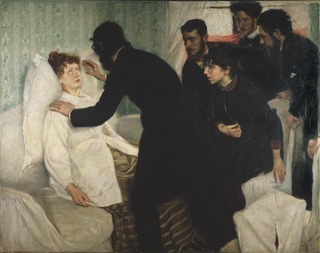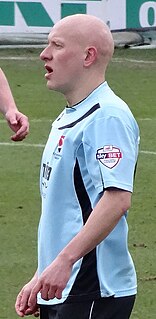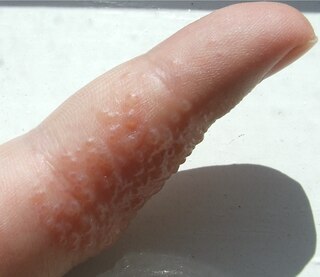Hypnodermatology is an informal label for the use of hypnosis in treating the skin conditions that fall between conventional medical dermatology and the mental health disciplines.

Hypnosis is a human condition involving focused attention, reduced peripheral awareness, and an enhanced capacity to respond to suggestion. The term may also refer to an art, skill, or act of inducing hypnosis.

Dermatology is the branch of medicine dealing with the skin, nails, hair and its diseases. It is a specialty with both medical and surgical aspects. A dermatologist is specialist doctor that manages diseases, in the widest sense, and some cosmetic problems of the skin, hair and nails.
Contents
The use of hypnosis to provide relief for some skin conditions is based on observations that the severity of the disease may correlate with emotional issues. In addition, hypnotherapy has been used to suggest improvement on dermatological symptoms, such as chronic psoriasis, [1] eczema, [2] ichthyosis, warts [3] and alopecia areata. [4]
Hypnotherapy is a type of complementary and alternative medicine in which the mind is used to help with a variety of problems, such as breaking bad habits or coping with stress.

Psoriasis is a long-lasting autoimmune disease characterized by patches of abnormal skin. These skin patches are typically red, dry, itchy, and scaly. On people with darker skin the patches may be purple in colour. Psoriasis varies in severity from small, localized patches to complete body coverage. Injury to the skin can trigger psoriatic skin changes at that spot, which is known as the Koebner phenomenon.

Alopecia areata, also known as spot baldness, is a condition in which hair is lost from some or all areas of the body. Often it results in a few bald spots on the scalp, each about the size of a coin. Psychological stress may result. People are generally otherwise healthy. In a few, all the hair on the scalp or all body hair is lost and loss can be permanent.
Philip D. Shenefelt, a research dermatologist at the University of South Florida School of Medicine, has identified two dozen dermatologic conditions that have shown response to hypnosis in the literature, with varying degrees of evidence. These include successful results in controlled trials on verruca vulgaris, psoriasis, and atopic dermatitis. [5] [6] A 2005 review in the Mayo Clinic Proceedings stated that, "A review of the use of hypnosis in dermatology supports its value for many skin conditions not believed to be under conscious control". [7] The most comprehensively studied skin conditions in relation to hypnotherapy are psoriasis and warts. [3] Hypnosis may have positive effects on dermatological conditions in both adults and children. [8]

University of South Florida Morsani College of Medicine is one of the graduate schools of the University of South Florida.

Atopic dermatitis (AD), also known as atopic eczema, is a type of inflammation of the skin (dermatitis). It results in itchy, red, swollen, and cracked skin. Clear fluid may come from the affected areas, which often thickens over time. While the condition may occur at any age, it typically starts in childhood with changing severity over the years. In children under one year of age much of the body may be affected. As children get older, the back of the knees and front of the elbows are the most common areas affected. In adults the hands and feet are the most commonly affected areas. Scratching worsens symptoms and affected people have an increased risk of skin infections. Many people with atopic dermatitis develop hay fever or asthma.
Hypnotherapy may contribute towards reducing itching and discomfort brought on by the presence of warts and improves and possibly decreasing lesions. [3]








